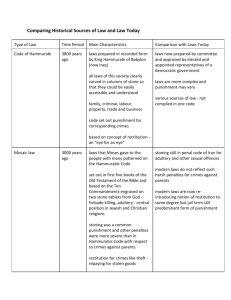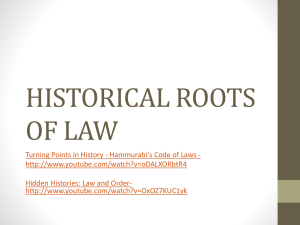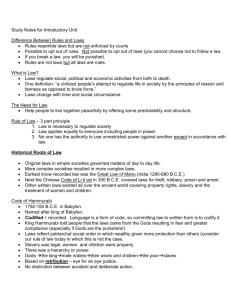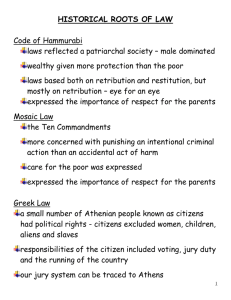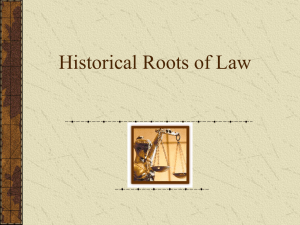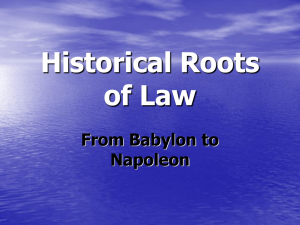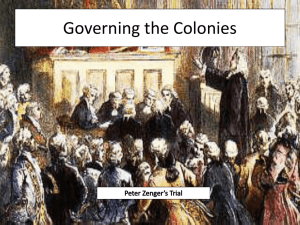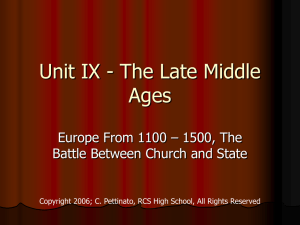Chapter 1: Law and Society
advertisement
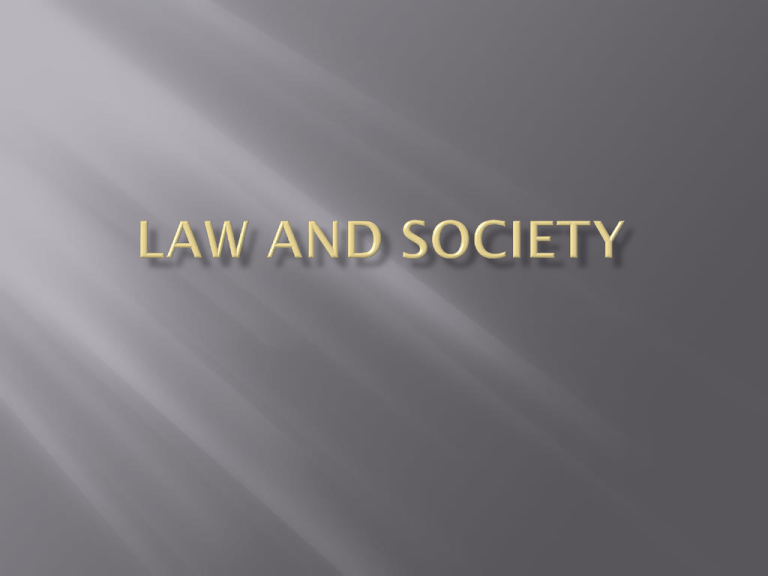
Everyone is governed by law. It is a part of our everyday life. Employees and employers are under labour laws. Laws to own and drive cars, rent or buy property. Laws regulating the use of the environment. Laws regulate what we eat and drink. Canada’s legal system strives to represent principles Canadians believe in an value. Over time laws change. It is important to study the law so that the legal system continues to work and can be effectively changed if needed to suit the values and morals of the current generation. What is a rule? What is a law? How are they the same? How are they different? Rules are like laws but are not enforced by the courts or legal system of Canada. Rules do not apply to everyone equally and can easily be changed compared to changing a law. The punishment for breaking a law is more severe than breaking a rule. Rules are not laws, but all laws are rules. Laws regulate our social, political and economic activities from birth till death. Laws restrict whom we marry, who gets our money when we die, whether we can put a swimming pool in our back yard A three part principle of justice: Individuals must recognize and accept laws are necessary to regulate society. The law applies equally to everyone. No one in society has the authority to exercise unrestricted power to take away our rights except in accordance with the law. Laws for the most part reflect our collective community standards. Laws based on morality suggest the values, attitudes, and beliefs that citizens hold in common. Individuals and groups who do not share these moral values are free to speak out publicly and try and change the law. All cases are the same should be treated the same and different cases differently. Laws are unjust if they discriminates on the basis of irrelevant characteristics. Justice should be impartial. Laws should conform to society’s values and beliefs. 1. 2. 3. 4. 5. 6. Why do you think it is important to study the laws of your country? How do rules differ from laws? Why do we need laws in society? Identify the three aspects of the Rule of Law. What is the relationship between the law and morality in Canadian society? Use your own examples to explain each of the four agreed upon characteristics of justice. One of the earliest code of laws is the Code of Hammurabi. Hammurabi was the king of Babylon and during his reign he codified or recorded the laws and penalties for every aspect of life in his kingdom. Many of Hammurabi’s laws were based either on retribution or restitution. If anyone is committing a robbery and is caught then he shall be put to death. If anyone opens his ditches to water his crops, but is careless, and the water floods the fields of his neighbour, then he shall pay for the loss. If a man takes a wife and she is seized by disease, and if he then desires to take a second wife, he shall not put away his first wife. But he shall keep her in the house and support her as long as she lives. If a man has a debt to repay, he can give his wife, son, or daughter as labor for three years to repay the money If fire breaks out in a house, and someone who comes to put it out takes the property of the master of the house, he shall be thrown into the same fire. If a man has destroyed the eye of another free man, his own eye shall be destroyed. If a builder has built a house for a man, and the house falls in, he shall replace all that has been destroyed; if it kills the householder, that builder shall be slain. If it kills the house owner's son or daughter, the builder's son/daughter will be put to death. One of the greatest influences on our law is biblical or Mosaic Law. These laws , now commonly called the Ten Commandments, were written 500 years after the death of Hammurabi. They punished the deliberate action more than an accidental act of harm. Mosaic law was more likely to punish the guilty party than allow a person of high status to shift punishment to a person of lesser status. A major difference was that in Mosaic law care for the poor was expressed as people were commanded to leave a portion of their crops for the poor to harvest. The earliest form of democracy was born in Ancient Greece. Citizens were required to vote, take part in the military and serve jury duty. The earliest jury can be traced to the Greek city of Athens as far back as 400 B.C. The largest Greek jury consisted of over 6000 members. There were two basic principles of Roman Law: The earliest Roman law code was known as the 12 Tablets. It was compiled by a committee of 10 men around 450 B.C. 1) The law must be recorded 2) Justice could not be left in the hands of judges alone to interpret. The tablets promoted the public prosecution of crimes, enacted a system of victim compensation, and protected the lower class. The laws became so complex as the Empire increased in size that it was common for people to seek legal advice from people who specialized in the law. Emperor Justinian of the Byzantine Empire commissioned 10 men to study and clarify the 1600 books of laws. These were reorganized and would become known as Justinian’s Code which would form the basis of modern day justice. Emperor Justinian who ruled from 527 to 565 A.D. After the Revolution in France in 1789 a man by the name of Napoleon Bonaparte gained power. He reorganized the legal system in France making the law more accessible to the public. As Napoleon conquered countries in Europe he brought with him his new legal system which regulated not only criminal issues but civil issues such as property, wills, contracts, and family law. Identify one of the earliest known written legal codes. Name the set of laws found in the Book of Exodus in the Bible. What role did the people known as citizens play in Greek society? Which society had the first paid legal advisers? How did the Justinian and Napoleonic Codes contribute to the development of modern law? Canadian law reflects many aspects of Mosaic, Greek, Roman and French law, but the greatest influence on our legal system is England. As Canada was once a colony of England we have inherited many of England's laws and traditions. Until close to 410 A.D. Great Britain was under Roman law. However after the fall of the Empire Roman laws gave way to local customs and traditions. Trial by Ordeal: In this situation the accused was to undergo torture and guilt or innocence was determined by the outcome. Trail by Oath Helping: Used in less serious cases; the accused could get friends to swear on the Bible that he or she was innocent. Trial by Combat: The two parties involved in a dispute would engage in a duel (swordfight). It was believed that God was on the side of the person who was truthful and therefore the winner would be proven right. Although in our present legal system there is no physical fighting it is based on the same principle of adversarial justice. During the Middle Ages Kings believed that their power was given to them by God which placed them “above the law”. This concept was known as “Divine Right”. In the feudal system in England each British lord was in control of a parcel of land (a fief) and everything and everyone in it was considered his property. Each lord ruled his land differently handing out justice as he saw fit. This would lead to discrepancies in the legal process across England. To deal with the differences across his country, King Henry II appointed judges, called assizes, to travel the land settling disputes. Theses assizes however had no codified law to judge by so they relied on their own common sense and local traditions. After a period of time they noticed similarities in cases and began to record judgments to help them and others deal with similar situations. This was the basis for case law or common law. Each time a decision was made it created a precedent or a standard which to go by. After time people began judging on precedent or earlier decisions of similar cases. This was known as stare decisis. Henry II died in 1189 and in June 1215 King John signed the Magna Carta. This was significant because it limited the power of the King and he was no longer above the law. The Magna Carta also called the Great Charter was the first step in establishing basic rights of the people of England. It recognized the concept of the Rule of Law. Another important part of the Magna Carta was the concept of Habeas Corpus. This guaranteed a person could not be held in jail without just cause. This concept still exists in our legal system today. When British and European settlers came to North America, they encountered well-established Aboriginal communities. Around 1450 five Aboriginal Nations came together and were joined by a sixth in 1720 to form the Iroquois Confederacy or Six Nations. The Constitution of the Confederacy was recorded in the Great Binding Law. The Great Binding Law outlined the rights, duties and responsibilities of the people and included laws covering adoption, emigration, treason and secession. How was trial by “oath helping” similar to the jury system of Greek law? How was it different? Describe the importance of the Magna Carta for the people of England? Explain the meaning of “case law”. Define the meaning of “rule of precedent”. Common law Code of Hammurabi Habeas Corpus Magna Carta Mosaic Law Rule of Law Rule of Precedent Restitution Retribution Case Law Codified Adversarial System Answer the Following Questions on page 31 in your text: 1: a,b,c,d,e,f,g,i,j,k,l 2: a,b 3 4 5 6


